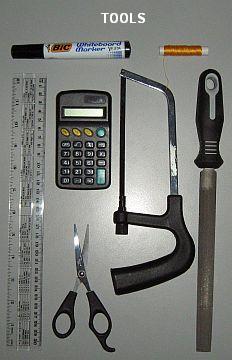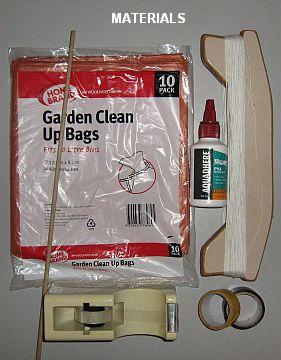
Kite Making Tools And MaterialsFor The Light-Wind MBK Dowel KitesThese 2 photos show absolutely all the kite making tools and materials needed. These dowel kites can be made over a carpet, but a hard surface is better when it comes to applying the edge tape to the sails.
ToolsSewing cotton. This stuff doesn't actually end up in the kite anywhere! It's just very handy sometimes for making sure a long flexible dowel is straight. A length of cotton is stretched in a straight line between 2 edges of the kite sail. At each end, the cotton is tacked down with a small piece of clear sticky tape. Using the marking pen, a couple of dots show exactly where the center of the dowel should lie. A ruler. Any length or type will do. All MBK kites use straight lines to make things easier and quicker. If the ruler is too short for a long sail edge, it's simple to use a dowel to put in 1 or more intermediate dots. These dots can then be connected using the small ruler. A small bend in the dowel doesn't matter, since the sail is symmetrical. A black marking pen. For drawing corner points and sail outlines on light-colored plastic. A pair of scissors. These are mainly for cutting around the outline of the sail. Also handy for cutting flying line to length for constructing bridles, trimming excess line, and snipping off lengths of electrical tape. A small cheap hack-saw for cutting wooden dowel to length. A cheap medium-grade wood file for rounding spar ends and cutting notches for securing bow-lines. Not everyone has kite making tools like saws and files just lying around the house, but these are very widely available in shops. A calculator. Yes, a calculator of some sort, like on your mobile phone or the Windows one or whatever. But there's no heavy calculating to be done, it's just handy for measuring where to put the dots on the plastic before drawing lines and cutting. A smooth flat area to work on. It only needs to be 2 meters (7 feet) square or so. Even if you are living in a tiny apartment, it's possible to use these kite making tools to get something impressive into the air! MaterialsElectrical insulation tape, available from hardware stores. This stuff stretches and therefore is perfect for capping spar ends while attaching sail plastic at the same time. Although a bit heavy, only small lengths are required so it doesn't add much weight overall. Lightweight, clear sticky tape. Scotch tape, Sello-tape, sticking tape, whatever you like to call it. Just make sure it is about the width of your finger. The tape I use is 12mm (1/2 inch) in width. This is used to reinforce the edge of the sail, since it doesn't stretch and doesn't add much weight. Large, translucent (see-through), colored plastic bags for making sails. Here in Australia, large orange garden bags are available from supermarkets. These bags are ideal, and also make the finished kite easy to see in the air! Use the lightest single-ply bags you can find for these Light-Wind kites. Color-wise, you must be able to see a black marker pen line through the plastic. The MBK construction method relies on this. Wood dowels. The one pictured is 4mm in diameter, which needs to be cut to length for the Dowel kites. As at late 2008, most MBK designs use less than $4 AUD worth of dowel. Hang onto those off-cuts, they might yet come in handy for making MBK Box Kites - when I get around to it! In North America, you could try 1/8" diameter dowel instead of 4mm, which will be significantly lighter than the Metric size. 6mm dowel is also used where more stiffness is required. The equivalent North American size is 1/2", which is actually quite close to 6mm. 16 kg (40 pound) or more flying line, for bridles and other lines attached to the frame. I'm using 50 pound braided Dacron for flying line and bridling. Strictly for light-wind flying, at the 1 meter size! If you want something slightly cheaper, you might use Nylon or good old cotton. Wood glue, such as the Aquadhere in the photo. For the Dowel kites, this is only used for securing knots! Hence only very small amounts are needed, and it dries much quicker than expected. A 100 ml container will last a long time when just used for making MBK kites. As long as you have access to supermarkets and hardware stores you should be able to get these kite making tools and materials together! Many of the items are probably lying around your house somewhere already. Last updated: 18 Dec 2008 Return to How To Make A Kite from Kite Making Tools... All the way back to Home Page |


